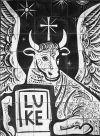
The Gospel of Luke
Overview of Lk 6,12-49
Establishing that we have a unity in this second part of chapter 6, 6,12-49, will be important for our reading because it will show us how the Sermon on the Plain is closely connected with the call of the apostles and that it follows on from it.
First then we need the boundaries. We have seen that following the breakdown of relations in 6,11, there is a major new beginning in 6,12 with "Now during those days" and the change of setting. We are told that Jesus goes up the mountain for a night of prayer (note as well 9,28). The conclusion (similar to Mt 7,28) comes in 7,1: "When Jesus had finished all these words to the people..." and Jesus then goes to Capernaum. There is no break so strong in between. 6,12 and 7,1 are the markers which show us the unity of the presentation 6,12-49.
We note though that there is another change of place in 6,17 following that of 6,12, from the mountain to the level place. Yet as we will see in more detail, 6,17 shows continuity with what precedes because Jesus is still with his chosen twelve ("he came down with them"). Thus we can connect the call of the apostles in 6,12-16 with the ministry to the crowds which follows in 6,17-19. This provides the immediate background to the sermon which opens with Jesus speaking in 6,20.
The Sermon on the Plain: 6,20-49
We now continue our examination of the text by looking at the third and longest section of the presentation, the sermon in 6,20-49. This is a major teaching by Jesus, commonly known as the Sermon on the Plain in contrast to the Sermon on the Mount of Matthew's Gospel.
Here I suggested you looked for three key phrases which mark the parts of the sermon. These are:
- verse 20: Jesus looked up at his disciples.
- verse 27: But I say to you who listen.
- verse 39: He also told them a parable.
- 6,20-26: Beatitudes and Woes
- 6,27-38: Loving and judging
- 6,39-49: Parable
Reading Plan
We have now established the framework of the sermon which will be the guide for our reading. It so happens that each of the three parts of the sermon is read on the three Sundays, 6th, 7th and 8th, in Ordinary Time. Each part is therefore best read on its own page. Including the setting up, we need four pages for our reading:
- 6,12-19 the call of the twelve and the setting up of the sermon
- 6,20-26 the beatitudes
- 6,27-38 loving and judging
- 6,39-49 parables
Let us now return to the main page for the next introductory step.
Two Sermons
Matthew's Sermon on the Mount (Mt 5-7) is Jesus' keynote speech for that Gospel with its formal beginning (Mt 5,1). The Sermon comes after the call of the disciples. In contrast, the keynote speech for Luke was given by Jesus in the synagogue in Nazareth, 4,16, before he called disciples.
Luke's Sermon on the Plain occurs further into the story and follows the commissioning of the group within the disciples whom he named Apostles.
Both sermons begin with the Beatitudes and end with the parable of foundations.
We can now take this further and note what the two sermons have in common:
| Luke | Matthew | ||
| Beatitudes | 6,17-23 | 5,1-12 | |
| Woes | 6,24-26 | cf. Mt 23 | |
| "But I say to you..." | 5,21-48 | ||
| Love your enemies | 6,27-36 | 5,43-48 | |
| The Golden Rule | 6,31 | 7,12 | |
| Judging others | 6,37-38 | 7,1-5 | |
| Blind guide | 6,39-42 | ||
| Good Fruit | 6,43-45 | 7,16-20 | |
| False prophets | 7,21-23 | ||
| Two foundations | 6,46-49 | 7,24-27 | |
| Conclusion | 7,1 | 7,28-29 |
The second part of Matthew chapter 5 is a series of sayings contrasting what was said of old with Jesus saying "But I say to you" (Mt 5,33-48). Of these, only "love your enemies" is used here by Luke (6,27-36) though he omits the introduction (Mt 5,43).
Luke also omits Matthew chapter 6. The theme of almsgiving, prayer and fasting will be considered by Luke later in the Gospel.
The third part of Luke's Sermon, 6,39-49, is similar to the ending of the Sermon on the Mount. We can look more closely at this when we come to our reading.
In conclusion, this looks like Luke adapting the Sermon on the Mount for his purposes even though we cannot be certain that he knew of the Sermon. The comparison shows the Luke's sermon needs to be read on its own terms. He has edited the Sermon on the Mount into something different for his own purposes.
Now we return to the main page in order to move on to the first two parts of the presentation.
